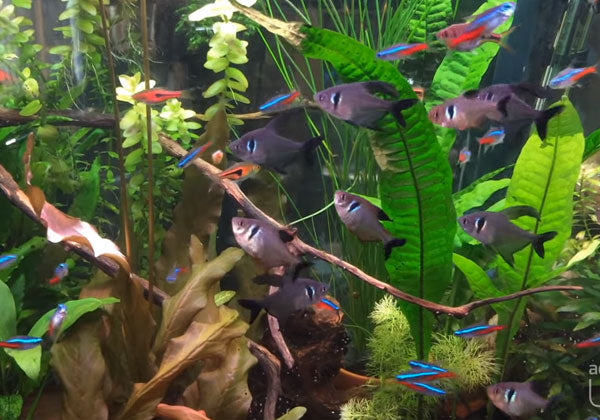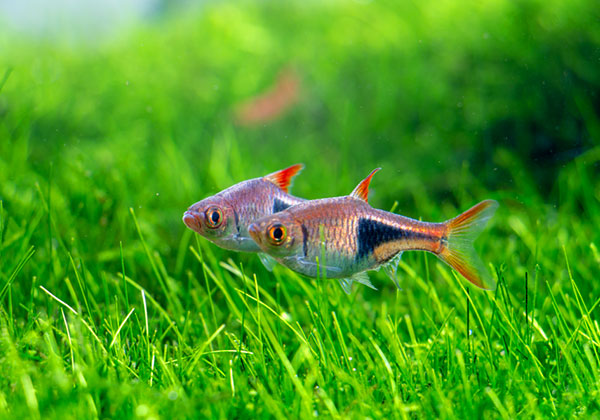Rasbora Hets and Espei Rasboras – Great For Planted Aquariums
The Rasbora fish species deserve their great popularity for so many reasons, including their docile temperaments, their easy care, their bright colors, and their relatively small size. They are a social fish, so it’s recommended that you get at least six of the kind that you choose!

Why are Rasboras so great for planted aquariums? It’s because their colors really pop out against the waving greenery of the background. The Harlequin Rasboras (Trigonostigma heteromorpha) have more of a pinkish brown tone, while the Lambchop Rasboras (Trigonostigma espei) have a brighter orange. Both fish feature a distinct darker black mark starting in the mid-belly and extending back towards the tail that contrasts really nicely with their environment. These fish aren’t really that into swimming amongst plastic plants, so you really want the real live plants. Your Rasboras will be so much happier!

Rasboras
Rasbora Fast Facts
Both Rasbora species are pretty hardy fish. They make a great beginner fish, especially once the tank has been cycled. As for their swim patterns, they tend to swim more in the middle to high portion of the tank, not dwelling too low.
These Rasbora fish have such a great easygoing personality with other fish. They’ll happily coexist with bettas and different types of tetras, including neon tetras, cardinal tetras, and black phantom tetras.
They’re social and they will school, especially when you do get six or more. In smaller schools, these fish will stress. You can definitely keep both types of Rasboras together in the same living quarters. They’re a bit timid and might swim away if you approach the tank.

Rasbora fish
They don’t grow to be very large sizes, about 2” max for the Rasbora hets (Harlequin) and slightly less for the Espei Rasboras (Lamb chop). These fish are omnivorous, so prepared flake food is one of your best food options. You can feed live foods, too, like daphnia, mosquito larvae, or brine shrimp.
Rasbora Tank Conditions
Both Harlequin and Lamb Chop Rasboras thrive well in an optimal water tank temperature of around 76 degrees Fahrenheit. The pH should be approximately 7.2, and the water hardness level is relatively soft. These requirements are different if you want to breed Rasboras, as they generally require a higher temperature and very soft, acidic water.

These Rasboras are tropical fish that live in fresh water, so water that comes straight from the tap is fine. You have to use a dechlorinator, a chemical additive that removes the chlorine from the water. Gravel is recommended at the bottom of the tank, to encourage the live roots to grow.
As for tank size, a small school of six Rasboras would live happily in at least a 10 gallon. We recommend a larger space because these fish do love to swim around. Make sure the tank is well filtered; a hang-on-back filter is one of the easiest to use and will keep your fish nice and healthy in their aquatic home.
Since Rasboras are pretty hardy and easy to care for, you’ll enjoy purchasing and keeping them for a long time to come!




